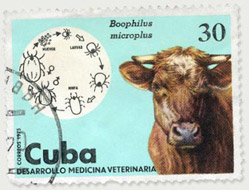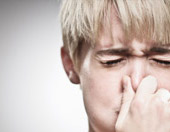

Tick prevention tips for you, your family and your pets
Posted in General Health & Wellness on April 25, 2011. Last modified on March 28, 2019. Read disclaimer.
Ah, the great outdoors - gardening, golfing, swimming at the lake, hiking with the dog and -- yikes! Is that a tick?!
Tiny ticks may look harmless enough but the potentially debilitating diseases they can carry shouldn't be minimized: Lyme disease and Rocky Mountain Spotted Fever are just a couple of the better known. Fortunately, there are simple steps we can take to reduce our risk of exposure to ticks and tick bites.
+ Free Shipping & Returns on Eligible Items.

Note: it's not only humans who are at risk. Dogs, cats, horses and any domestic animals - even many species of wild birds - are vulnerable to tick borne diseases. Note also: a tick bite does not necessarily automatically result in the host contracting a tick borne illness. The likelihood of infection depends on where you live, whether or not the offending tick was infected, how long the tick was attached, how it is removed, and even the type of tick - dog, deer, wood, etc.. (Check this CDC map to see which species of ticks are common in your area.)
Understanding tick tendencies can help us reduce the risk of tick exposure and tick bites.
Ticks prefer moist, humid, shaded habitats and are most active in warmer months -- from late spring to early autumn. They tend to climb in leaf litter, on logs, or up to the tips of shrubs or tall grass and wait - legs extended - for a passing host to brush by. The tick is looking for a place to bite and feast on blood. They can be attracted to a host by odor (such as the carbon dioxide in our breath), moisture, vibration, body heat and even shadows. Some tick species bite in quickly, while others travel up the body for a while, preferring the thinner skin of the scalp or ears.
Tips for avoiding ticks and preventing tick bites.
Around the house:- Keep your lawn mowed and minimize brush and leaf litter.
- Keep wood piles dry and away from the house or common play areas.
- Create a barrier zone of wood chips or gravel between your lawn and woods.
- Discourage deer, rodents and any wild mammals from your yard as all are common tick hosts.
- Apply a lawn pesticide, formulated to kill ticks (liquid or granular bifenthrin or permethrin), at the optimal time of the year for your area. In most cases, you can safely limit the amount of pesticide used by focusing on the lawn perimeter, shady flower beds and along wooded trails.
- Trim branches or shrubs, allowing as much sunlight onto your yard as possible.
- When hiking, stay in the center of roads and trails, away from brush and vegetation.
- Check yourself and others (including pets) carefully after every outing - especially in out of site places like under arms, in and around ears, scalp, groin, around belt line, back of knees and even inside the belly button. CAREFUL INSPECTION MAY BE THE SINGLE MOST IMPORTANT STEP FOR PREVENTING TICK BITES AND TICK BORNE ILLNESSES.
- Apply Permethrin-based tick repellent. DEET-based bug repellents are very ineffective against ticks, according to the Univ. of Rhode Island Tick Encounter Center. So they strongly endorse Permethrin-based products (which should be applied only to clothing and allowed to dry before wearing, tents, netting, etc.). Follow application instructions carefully. Clothes commercially treated with permethrin can provide tick protection for up to 70 washings. (Do-it-yourself permethrin-sprayed clothing loses effectiveness after 5 or 6 washings.)
- Shower thoroughly with a washcloth and as soon as possible after each outing.
- Check clothing for ticks. They can survive machine washing but are killed when clothes are placed in the dryer on high heat (see tips for killing any ticks in your home).
- Wear light-colored clothing, which makes it easier to see ticks.
- Tuck in your shirt and tuck pant legs into socks or boots (even, perhaps, duct taping them in place) to slow the tick's access to your skin.
- Keep animals out of tall grass, leaves, and woods.
- If your pet has been outside, brush his or her fur vigorously with a flea comb -- since it usually takes 10 minutes or more for ticks to attach.
- Inspect pets carefully and regularly -- especially in areas where there is less fur: around ears, in arm pits, on the belly and between toes. Though they may be difficult to see under the fur, ticks can often be felt as small bumps on your pet's skin.
- As much as possible, eliminate mice, skunks, raccoons, stray dogs and cats, and other tick-carrying "hosts" from your yard.
- Be consistent with your tick prevention medication program such as spot-on medicines or a tick collar, etc.
- Don't share your bed with dogs or cats. Ticks that fall off them may find an easy meal on sleeping humans.
- Avoid using a hot nail, matches, petroleum jelly or gasoline. Not only are these tick removal techniques ineffective, they can actually increase the chances of disease transmission.
- The effectiveness of specialized tick removal devices varies dramatically.
- The Centers for Disease control says that the best way to remove a tick is with a fine-tip tweezers or forceps. Grasp the embedded tick as close down as possible to the person's or pet's skin, being certain to include the tick's head and mouthparts. Pull straight up, steadily, with even pressure. If you accidentally separate the body from the mouth parts and are unable to remove the mouth parts with a tweezers, leave it alone and let the skin heal. Wash the bite area with soap and water, rubbing alcohol or iodine and watch for signs of tick borne diseases or localized infection at the bite area over the next 30 days. Liquid tick removers, which have come to market in the last few years, do not kill a tick but make removal much easier. They do this by dissolving the chemical bond between a tick's mouth and your skin while encouraging the tick to back out on its own.

Killing Ticks in Your Home
Ticks eat blood, and nothing else. Plus, they need very humid conditions. So, inside the home, unfed ticks will usually dry out and die within a day. And, while fed ticks may live longer, they almost certainly won't live long enough to lay eggs.
Tick Prevention Tip: Ticks can survive 2-3 days in a damp hamper where you, your pets or family members may become exposed. So, if you've come in from outdoors and think you may have picked up ticks, remove your clothes and either: (A) immediately wash the clothes and dry them thoroughly in the laundry dryer or (B) throw those clothes in the dryer for 10-15 minutes to dehydrate and kill any ticks before tossing the clothes in the dirty laundry hamper.
Resources:
http://www.cdc.gov/ticks/life_cycle_and_hosts.html
http://healthvermont.gov/prevent/lyme/landscape.aspx
http://www.ct.gov/caes/lib/caes/documents/publications/fact_sheets/tickbiteprevention05.pdf
http://www.cdc.gov/Features/StopTicks/
http://www.cdc.gov/ticks/avoid/on_people.html
http://www.cdc.gov/ncidod/dvbid/lyme/resources/handbook.pdf
http://www.cdph.ca.gov/HealthInfo/discond/Pages/Ticks-Kids.aspx
http://www.cdph.ca.gov/HealthInfo/discond/Documents/Dontlettheticksbite.pdf
http://www.tickencounter.org/faq/tick_habitat#tickhabitat_question_04

 Finding healthy, loving, adult relationships
Finding healthy, loving, adult relationships 6 Tips for staying motivated
6 Tips for staying motivated Why we should all be eating onions and garlic
Why we should all be eating onions and garlic How to stop hiccups
How to stop hiccups How to get the best treatment from your doctor
How to get the best treatment from your doctor Guarding against ticks and diseases they carry
Guarding against ticks and diseases they carry Safety tips for playground activities
Safety tips for playground activities Networking ideas for single parents
Networking ideas for single parents Single parent support resources
Single parent support resources Why it's never too late to stop smoking
Why it's never too late to stop smoking Controlling gas, constipation, and heartburn
Controlling gas, constipation, and heartburn